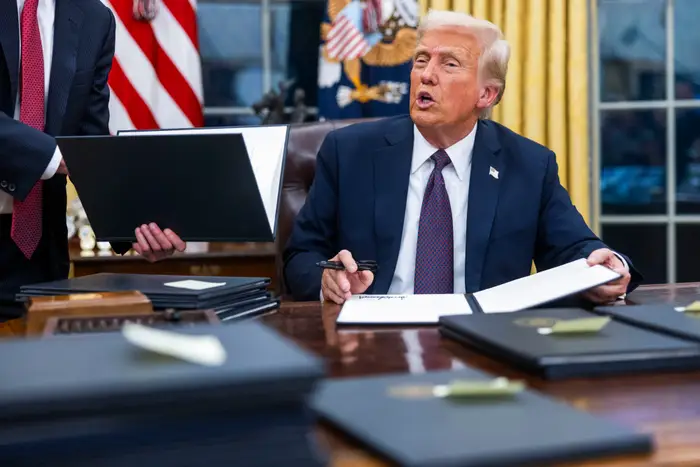U.S. President Donald Trump has announced plans to implement a 25% tariff on steel and aluminum imports starting Monday, a decision that has sparked strong reactions from Europe and China. The move has raised concerns about potential retaliatory measures and the broader impact on global trade.
Speaking aboard Air Force One on Sunday, Trump confirmed that the tariffs would apply to “any steel coming into the United States,” emphasizing that aluminum imports would also be affected. This policy mirrors similar measures he implemented during his 2017-2021 presidency, aimed at protecting U.S. industries from what he considered unfair competition from Asian and European markets.
The European Commission stated on Monday that it had not received an official notification regarding the tariffs. However, French Foreign Minister Jean-Noel Barrot warned that the European Union would respond in kind. “There is no hesitation when it comes to defending our interests,” Barrot said in an interview with broadcaster TF1. The European Commission further emphasized its readiness to protect European businesses, workers, and consumers from “unjustified measures.”
Canada, a key supplier of steel and aluminum to the U.S., is also under threat of tariffs, alongside major exporters such as Brazil, Mexico, and South Korea. According to trade analysts, approximately 25% of European steel exports are destined for the U.S., and any additional duties could severely impact the sector. Roland Berger, a consulting firm, cautioned that “any tax from the United States would hurt the European sector.”

Germany’s Economy Minister Robert Habeck described the situation as a “lose-lose” scenario. “A tariff conflict only has losers,” he stated, adding that Europe must react in a “united and determined manner.”
Trump also announced plans for “reciprocal tariffs” to align U.S. trade policies with those of other nations. “Every country will be reciprocal,” he declared, promising further details on Tuesday or Wednesday. This approach reflects his broader strategy of leveraging tariffs as a tool for economic negotiations, which he has previously used against key trade partners including China, Mexico, and Canada.
During his first term, Trump temporarily suspended a 25% tariff on Canada and Mexico after both countries agreed to crack down on fentanyl trafficking and unauthorized border crossings. However, the tariffs against China proceeded, with additional levies of 10% imposed on Chinese imports last Tuesday. In response, Beijing announced retaliatory tariffs on select U.S. goods, including coal and liquefied natural gas, set to take effect on Monday. Analysts at Goldman Sachs estimate that the new Chinese tariffs will impact $14 billion worth of American exports, whereas Trump’s measures target approximately $525 billion worth of Chinese goods.
Chinese Foreign Ministry spokesperson Guo Jiakun reiterated Beijing’s stance, stating, “There is no winner in a trade war and tariff war.”
Trump has also signaled possible tariffs on the European Union, further escalating trade tensions. French President Emmanuel Macron, in an interview with CNN, vowed to challenge Trump’s financial threats against Europe, arguing that the U.S. should prioritize its trade concerns with China rather than the EU. Macron also cautioned that tariffs on European goods would “increase costs and create inflation in the U.S.”
Similarly, Trump has warned Japan that it could face trade penalties if it fails to reduce its trade deficit with the U.S. Despite a seemingly cordial meeting with Japanese Prime Minister Shigeru Ishiba on Friday, Trump maintained that he expects significant changes in trade relations.

The U.S. trade deficit, the largest in the world, expanded last year to nearly $920 billion. Trump has pledged to usher in a “new golden age” for the U.S. economy, insisting that tariffs will primarily impact foreign exporters rather than American consumers. However, economic experts widely disagree, arguing that tariffs will ultimately lead to higher prices for U.S. consumers.
Trump has frequently used tariffs as leverage to achieve broader policy goals. Most recently, he threatened to impose tariffs on Colombia after it turned back U.S. military planes carrying deported migrants. Following a day-long standoff, the Colombian government relented to U.S. demands.
With global trade partners gearing up for countermeasures, the latest round of tariffs is expected to heighten tensions and disrupt international supply chains in the coming months.



